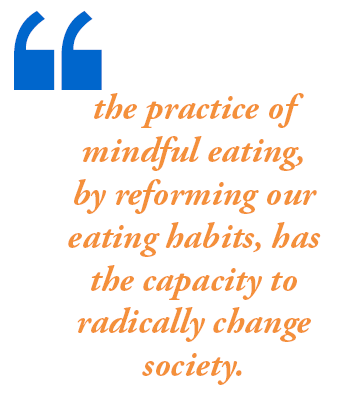Mindful Eating - Ayurveda

In our world of disordered eating, mindful eating offers a way of addressing the mindlessness around various aspects of food, with the potential for radical change. The simple act of bringing awareness to what we are doing now can open up our understanding of how we feel when our minds or our hearts are hungrier than our stomachs.
Mindfulness brings an awareness of choices. And in learning how to choose what nourishes us best we enable ourselves to deliberately engage in a fundamental biological act, the act of providing nourishment for ourselves. With its non-prescriptive approach and simple instructions based on non-judgemental awareness and observation, mindful eating serves as a direct antidote to the frantic obsession with the next new wonder diet and/or the manifestation of the latest super food. It speaks to us quietly and kindly: when eating, just eat.
The process of nourishment involves five stages:
1. procuring of food (foraging, hunting, growing/harvesting, exchange or shopping)
2. preparing (washing, peeling, chopping, kneading, cooking, baking, microwaving)
3. eating
4. digesting
5. eliminating
The first two practices- procuring and preparing - have changed radically in the recent past. We no longer forage or hunt for our food, and most of us no longer grow and harvest it either. More likely, in this post-industrial age, we just buy it. And how do we mindfully engage with acts of procurement? Increasingly, the preparation stage has been reduced to reheating industrially processed food, or, if we choose to eat out, to doing nothing.
So how can we undertake to shop for food mindfully? You are in a supermarket under neon lights, trying to locate a few ingredients for dinner. Aisle after aisle of garishly over-packaged items, shouting out to be bought: “100% natural”, “50% more”, “Gourmet”, “Homemade”, and on and on. Where does this food come from? What effect your buying has on the world? And how will it affect your body and mind? These are questions to consider when eating mindfully, but they are not always easy to answer.
Yet, what we eat has a huge influence not only over our well-being. In the age old Indian spiritual tradition that is the root of mindfulness, yoga, and Ayurveda, food is classified according to its effect on the body and mind. This system uses the three Gunas: Sattva (the quality of love, light and life), Raja (the quality of activity and passion, lacking stability) and Tamas (the quality of darkness and inertia, dragging us into ignorance and attachment).
Sattvic food promotes clarity and calmness of mind and is favourable for spiritual growth. It is "sweet, fresh and agreeable" and includes most fruits, nuts, seeds, vegetables, particularly green leafy vegetables, whole grains, honey, pure water, and milk (with the reservation that commercially produced milk may not nowadays be so Sattvic).

Given the amount of pesticides and chemical fertilisers used on commercial crops, even fresh fruit and vegetables may no longer all be regarded as Sattvic. Being mindful of the disastrous effect that industrial agriculture is having not only on the quality of the food we are presented with, but also on the environment can guide our food shopping choices.
Rajasic food feeds the body, but promotes activity and therefore induces restlessness of mind. It disturbs the equilibrium of the mind and is generally best avoided. Rajasic foods include most spicy foods, stimulants like coffee and tea, eggs, garlic, onion, meat, fish and chocolate, as well as most processed food. Eating too fast or with a disturbed or distracted mind is also considered Rajasic, and the practice of mindful eating is a great antidote to this.
Tamasic food induces heaviness of the body and dullness of the mind, and ultimately benefits neither. It includes alcohol, as well as food that is stale or overripe and no longer contains any life force. Overeating is also Tamasic, as it over burdens the digestive system which has to turn all this extra food into waste, and it dulls the mind. The traditional advice is to fill the stomach half with food, one quarter with water, leaving the last quarter empty. Mindfulness can help us to recognise satiety signal from the body and stop eating at the right time.
Being mindful in our eating and in the other practices involved with our nourishment can help us withstand the mindlessness that permeates much of our western food culture. As such, the practice of mindful eating, by reforming our eating habits, has the capacity to radically change society.
According to the website of The Centre for Mindful Eating, based in the US, someone who eats mindfully is an individual who:
1. By choice, directs their attention to eating on a moment-by-moment basis.
2. Gains awareness of how they can make choices that support health and well-being.
3. Becomes aware of the interconnection of earth, living beings, and cultural practices and the impact of their food choices on those systems.
What choices we will make that support not only our own health and well-being, but also those of the planet we live on?

Christophe was born in France and moved to Ireland over 20 years ago. He has lived a very varied life and worked in many different areas, including tourism, IT, teaching yoga and farming. For more info on workshops and retreats see
yogaretreats.ie
ecofarm.ie
Latest Issue
Upcoming Events
-
17/04/2020 to 26/04/2020
-
18/04/2020
-
23/04/2020
-
15/05/2020 to 23/05/2020
-
16/05/2020 to 17/05/2020
Recent Articles
Article Archive
- November 2011 (2)
- January 2012 (3)
- February 2012 (2)
- March 2012 (2)
- April 2012 (4)
- May 2012 (4)
- June 2012 (1)
- July 2012 (3)
- August 2012 (2)
- October 2012 (2)

